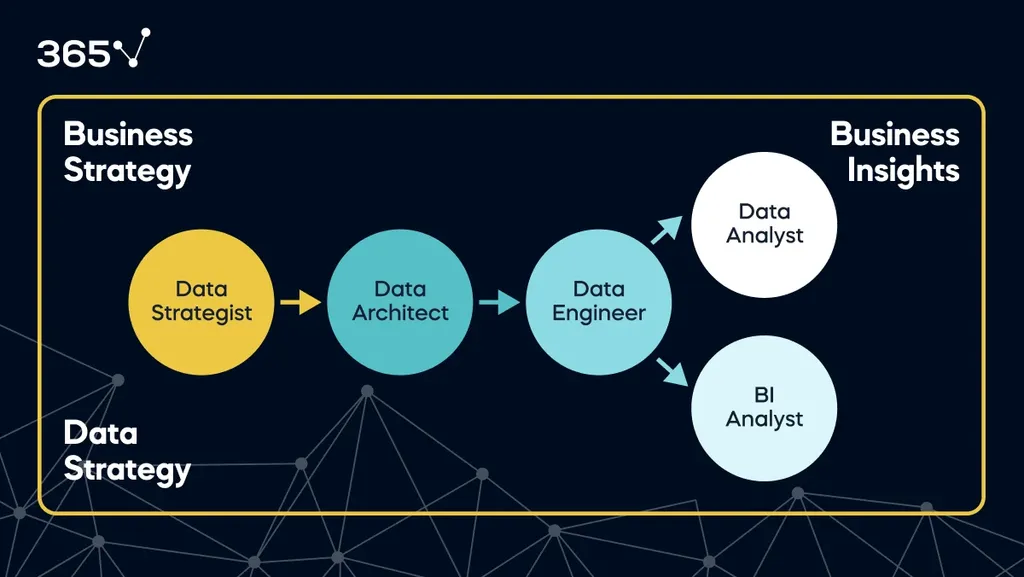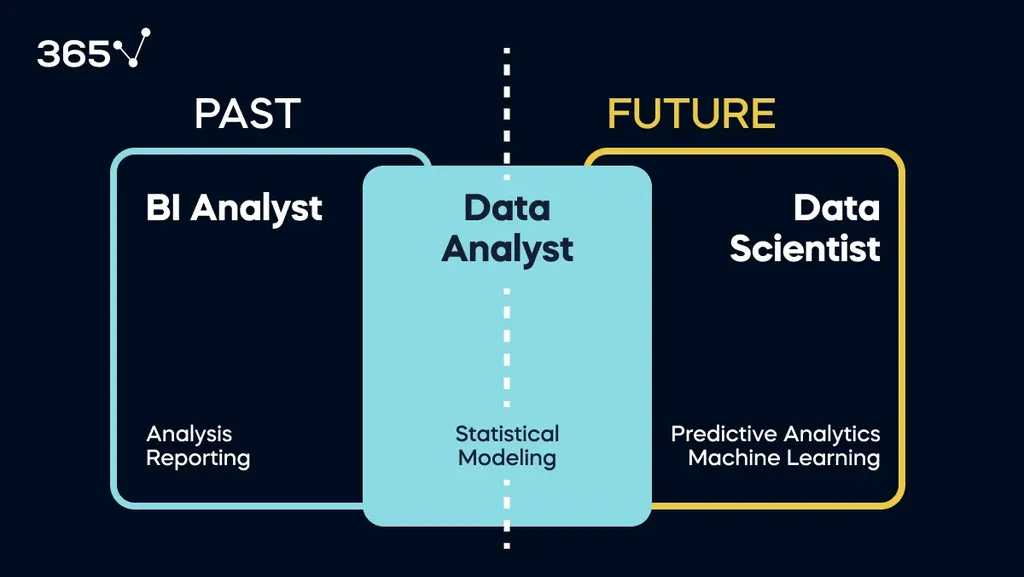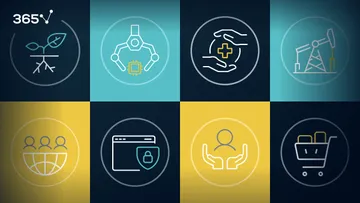Working with data is a meta skill; there’s not only one specific skill set required to succeed in this line of work. Although this creates many opportunities, it can become overwhelming when looking for a job.
Companies recruit for various data science roles, and each of these positions requires different competencies. So, our aim is to describe who does what and how data professionals with different job titles contribute to a business.
Watch the video below for a brief overview of the topic and read on to learn more.
Types of Data Science Roles: Table of Contents
- Data Strategist
- Data Architect
- Data Engineer
- Data Analyst
- Business Intelligence Analyst
- Data Scientist
- ML Ops Engineer
- Data Product Manager
- Types of Data Science Roles: Next Steps
Data Strategist
Ideally, before a company collects any data, it hires a data strategist—a senior professional who understands how data can create value for businesses.
According to the famous data strategist Bernard Marr, there are four main ways how companies in different fields can use data science:
- They can make data-driven decisions.
- Data can help create smarter products and services.
- Companies can use data to improve business processes.
- They could create a new revenue stream via data monetization.
Companies often outsource such data roles. They hire external consultants to devise a plan that aligns with the organizational strategy.
Once a firm has a data strategy in place, it is time to ensure data availability. This is when a data architect comes into play.
Data Architect
A data architect (or data modeler) plans out high-level database structures. This involves the planning, organization, and management of information within a firm, ensuring its accuracy and accessibility. In addition, they must assess the needs of business stakeholders and optimize schemas to address them.
Such data roles are of crucial importance. Without proper data architecture, key business questions may remain answered due to the lack of coherence between different tables in the database.
A data architect is a senior professional and often a consultant. To become one, you’d need a solid resume and rigorous preparation for the interview process.
Data Engineer
The role of data engineers and data architects often overlaps—especially in smaller businesses. But there are key differences.
Data engineers build the infrastructure, organize tables, and set up the data to match the use cases defined by the architect. What’s more, they handle the so-called ETL process, which stands for Extract, Transform, and Load. This involves retrieving data, processing it in a usable format, and moving it to a repository (the firm’s database). For example, they might convert XML data into readable, structured database tables that can be queried with SQL. Simply put, they pipe data into tables correctly.
Typically, they receive many ad-hoc ETL-related tasks throughout their work but rarely interact with business stakeholders directly. This is one of the best-paid data scientist roles, and for good reason. You need a plethora of skills to work in this position, including software engineering.
Okay, let’s recap.
As you can see, the jobs in data science are interlinked and complement each other, but each position has slightly different requirements. First come data strategists who define how data can serve business goals. Next, the architect plans the database schemas necessary to achieve the objectives. Lastly, the engineers build the infrastructure and pipe the data into tables.

When it comes to deriving insights, we can distinguish between three data roles—data analyst, BI analyst, and data scientist. Although there’s a big overlap, these are separate positions.
The 365 Introduction to Data Science Course provides a detailed yet simple explanation of these roles. Here’s a brief overview of the main differences between data science, BI, and analytics job titles.
Data Analyst
Data analysts explore, clean, analyze, visualize, and present information, providing valuable insights for the business. They typically use SQL to access the database.
Next, they leverage an object-oriented programming language like Python or R to clean and analyze data and rely on visualization tools, such as Power BI or Tableau, to present the findings.
Business Intelligence Analyst
Data analyst’s and BI analyst’s duties overlap to a certain extent, but the latter has more of a reporting role. Their main focus is on building meaningful reports and dashboards and updating them frequently. More importantly, they have to satisfy stakeholders' informational needs at different levels of the organization.
Data Scientist
A data scientist has the skills of a data analyst but can leverage machine and deep learning to create models and make predictions based on past data.
We can distinguish three main types of data scientists:
- Traditional data scientists
- Research scientists
- Applied scientists
A traditional data scientist does all sorts of tasks, including data exploration, advanced statistical modeling, experimentation via A/B testing, and building and tuning machine learning models.
Research scientists primarily work on developing new machine learning models for large companies.
Applied scientists—frequently hired in big tech and larger companies—boast one of the highest-paid jobs in data science. These specialists combine data science and software engineering skills to productionize models.
More prominent companies prefer this combined skillset because it allows one person to oversee the entire ML implementation process—from the model building until productionization—which leads to quicker results. An applied scientist can work with data, model it for machine learning, select the correct algorithm, train the model, fine-tune hyperparameters, and then put the model in production.
As you can see, there’s a significant overlap between data scientists, data analysts, and BI analysts. The image below is a simplified illustration of the similarities and differences between these data science roles.

ML Ops Engineer
Companies that don’t have applied scientists hire ML Ops engineers. They are responsible for putting the ML models prepared by traditional data scientists into production.
In many instances, ML Ops engineers are former data scientists who have developed an engineering skillset. Their main responsibilities are to put the ML model in production and fix it if something breaks.
Data Product Manager
The last role we discuss in this article is that of а product manager. The person in this position is accountable for the success of a data product. They consider the bigger picture, identifying what product needs to be created, when to build it, and what resources are necessary.
A significant focus of such data science roles is data availability—determining whether to collect data internally or find ways to acquire it externally. Ultimately, product managers strategize the most effective ways to execute the production process.
Here is a summary of the roles discussd in this article:
|
Role |
Primary Focus |
Key Responsibilities |
Interaction with Stakeholders |
Skillset Required |
|
Data Strategist |
Defining how data can serve business goals |
Making data-driven decisions Creating smarter products/services Improving business processes Data monetization |
High |
Strategic planning, business acumen |
|
Data Architect |
Planning database schemas to achieve business objectives |
Designing high-level database structures Ensuring data accuracy and accessibility Optimizing schemas for business needs |
Moderate |
Information management, database design |
|
Data Engineer |
Building infrastructure and managing data flow |
Building and organizing data infrastructure Handling ETL processes |
Low |
Software engineering, data management skills |
|
Data Analyst |
Analyzing and visualizing data for insights |
Exploring, cleaning, analyzing, and visualizing data Presenting information |
Moderate |
SQL, Python/R, Excel, data visualization tools (e.g., Power BI, Tableau) |
|
Business Intelligence Analyst |
Reporting and dashboarding for business insights |
Building and updating reports and dashboards Satisfying informational needs at different organizational levels |
High |
Reporting tools, data visualization, understanding of business needs |
|
Data Scientist |
Predictive analytics and machine learning |
Advanced statistical modeling Building and tuning machine learning models Experimentation via A/B testing |
Moderate |
Advanced analytics, machine learning, programming |
|
ML Ops Engineer |
Operationalizing machine learning models |
Putting ML models into production Managing model maintenance and updates |
Moderate |
Engineering skillset, understanding of machine learning operations |
|
Data Product Manager |
Overseeing the success of a data product |
Identifying product needs Strategizing product creation and resource allocation Ensuring data availability |
High |
Product management, strategic vision, data understanding |
Types of Data Science Roles: Next Steps
We hope this helps you navigate the multifaceted world of data science. You can choose between a variety of data science roles; find your niche and start preparing for your dream job.
You can begin with one of our career tracks – they cover the fundamentals and build up your skillset through practical examples and exercises. Sign up now and begin your path to a successful career as a Data Scientist, Data Analyst, or Business Analyst.
FAQs







